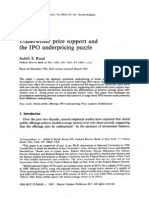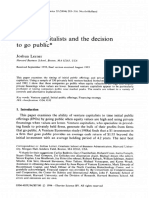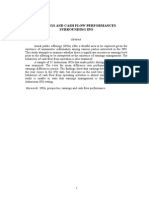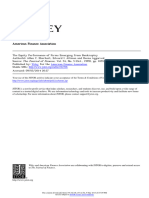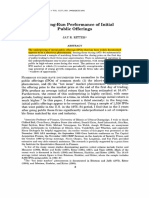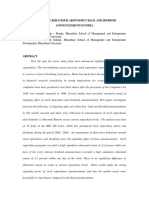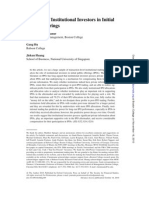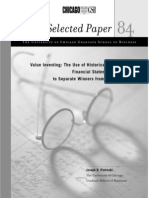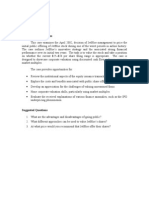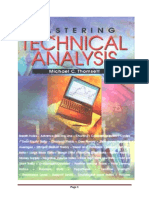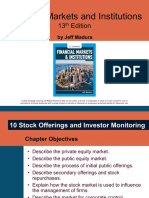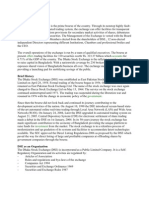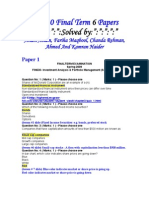Philip J. Lee-1999
Philip J. Lee-1999
Uploaded by
EndiNugrohoCopyright:
Available Formats
Philip J. Lee-1999
Philip J. Lee-1999
Uploaded by
EndiNugrohoOriginal Description:
Copyright
Available Formats
Share this document
Did you find this document useful?
Is this content inappropriate?
Copyright:
Available Formats
Philip J. Lee-1999
Philip J. Lee-1999
Uploaded by
EndiNugrohoCopyright:
Available Formats
JOURNAL OF FINANCIAL AND OUANTITATIVE ANALYSIS
VOU. 34. NO. 4. DECEMBER 1999
IPO Underpricing Explanations; Implications
from Investor Application and Allocation
Schedules
Philip J. Lee, Stephen L. Taylor, and Terry S. Walter*
Abstract
Initial Public Offers (IPOs) made on the Stock Exchange of Singapore routinely provide
sufficiently detailed data to allow rcconstniction of both the application and allocation
schedules. We show that large investors tend to preferentially request participation in IPOs
with higher initial returns, consistent with these investors being better informed. We also
show that inferences based exclusively on application strategies are quite different from
those drawn on investor allocations. Our results suggest that caution is necessary in assessing the relative merit of competing explanations for IPO underpricing where the underlying
demand is not identified.
I.
Introduction
Institutional practices adopted in initial public offerings (IPOs) are an impor-
tant determinant of initial underpricing (Loughran, Ritier, and Rydqvist (1994)).
The "book-building" approach of U.S. underwriters means that there should be a
close correspondence between final applications for shares in an IPO atid the allocation of these shares.' Final applications, however, may differ substantially from
the underlying demand for an issue, reflecting potential investors' perceptions of
bias in underwriters' allocation decisions and the futility of an application for
shares when not on the "favored client" list. When underlying demand is dampened in this way, it is not possible to observe the probability of an allocation, and
theories that rely on differentially informed investors cannot be directly tested.^
* All authoni. Department of Accouming (H04), tJniversity of Sydney. NSW 2006. Australia. This
paper has benefited from commenLs by panicipants at the 1996 PACAP/APFA annual meeting, as
well a-s workshops at the following universities: Sydney, Adelaide. Western Australia. Macquarie, and
Queensland. The authors gratefully acknowledge these comments. They also acknowledge detailed
comments and suggestions received from Philip Brown. Paul Malatesta (the editor), and Wo Welch
(a.>isociate editor and referee),
' Following pre selling, U,S, underwriters must set a common price for all investors (Benveniste
and Wilhelm (1990)), The subsequent offers of .shares rcHect underwriters' allocation di.scretion. as
well as the Information gained from pre-selling. Hence, "applications." as such, will already reflect
both ihc information provided in ihe pre-selHng period and the underwriters' ability to discriminate
bciween applicants,
^It is possible that investors might strategically apply for a larger number of shares than they
actually want in an issue. To do so. however, involves an additional application cost, and an increa.sed
425
426
Journal of Financial and Quantitative Analysis
Indeed, the extent of differentially informed investors becomes a maintained assumption, rather than a subject of investigation.
We examine stock issues in Singapore and show that large investors preferentially request partieipation in IPOs with higher initial returns, consistent with
them having better information. While larger investors are commonly assumed to
have an information advantage, our paper is the first to document it empirically.
We also show that the winner's curse (Rock (1986)) is far more apparent in applications than it is in allocations. Data for Singapore IPOs are frequently sufficient
to reconstruct the demand schedule within various application sizes, as well as a
schedule of how that demand is rationed (i.e., allocation data). Thus, we can make
a direct comparison of the inferences drawn from allocation data vis a vis those
that derive from application data (i.e., unconstrained demand). To the extent that
differences between unconstrained demand and eventual allocation patterns exist
in the U.S. and elsewhere, our results also suggest that conclusions based only on
allocation data need to be cautiously interpreted.
Our results need to be considered in light of the prevailing institutional setting for Singapore IPOs. Underwriting in Singapore is cvenhanded, in contrast
to the book-building approach adopted in the U.S. All investors who apply for
the same number of shares in an IPO have an equal chance of success (though
issuers can choose to ration requests for different numbers of shares more or less
severely), because over-subscribed issues are allocated using a process of random
drawing. Koh and Walter (1989) and Lee, Taylor, and Walter (1996b) confirm the
winner's curse prediction for short-run underpricing, and also show that long-run
returns for Singapore IPOs are consistent with efficient market expectations. The
long-run secular decline in price documented in several international studies (see
Loughran, Ritter, and Rydqvist (1994) and Lee, Taylor, and Walter (1996a)) is not
present in Singapore.
The next section highlights the role of informed investors in two widely
tested explanations for IPO underpricing, as well as the key institutional arrangements for the Singapore IPO market. The data used in this study are described in
Section III, together with the results. Application and allocation details are analyzed to discover the nature of demand expansion and its relationship with IPO
rationing. The conclusions are presented in the final section.
11. Background
A.
Prior Research
Differentially informed investors play a crucial role in many explanations of
IPO underpricing. For example, in Rock's (1986) winner's curse model, informed
investors only request stock in issues they know to be underpriced, thereby creating an adverse selection problem for issuers that leads to underpricing, on average, of IPOs. In Benveniste and Spindt's (1989) information-gathering model,
informed investors provide valuable demand and pricing feedback to underwriters, and underpricing, on average, compensates for the value of this information,
probability ihai, if the i.ssue is overpriced, ihcy will face ihe consequcnl winner's curse. More delail
on ihe cost structure and institutional arrangements in Singapore IPO.s is provided in Section II.B,
Lee, Taylor, and Walter
427
as well as the cost of participating in overpriced issues. While distinguishing between the role of these (and other) models requires consideration of the prevailing
institutional setting, Hanley and Wilhelm (1995) also argue that the behavior of
informed investors will differ in important aspects between the winner's curse and
information-gathering models. Hence, Hanley and Wilhelm endeavor to "test"
these competing explanations for IPO underpricing by examining outcomes for
informed investors. They use confidential allocation data for a limited number of
U.S. IPOs and show that institutional (i.e., informed) investors receive approximately the same proportions of shares in overpriced and underpriced issues. They
interpret this result as support for Benveniste and Spindt's (1989) explanation
of IPO underpricing, which is premised on discriminatory behavior by U.S. underwriters, and reject the winner's curse explanation proposed by Rock (1986).
Specifically, they show that variation in the proportion of the issue allocated to
institutional investors explains a statistically insignificant (though positive) proportion of cross-sectional variation in initial returns.
Hanley and Wilhelm interpret their evidence to imply that informed investors
are forced by underwriters to take shares in overpriced issues. It is also plausible
that informed investors take more reliably overpriced issues because of unobservable "scaling back" via the pre-selling process or a bias in rationing relative
to uninformed investors. More generally, it is even possible that results such as
those reported by Hanley and Wilhelm may simpiy reflect an absence of superior information among institutional investors, so that they cannot be expected to
discriminate between overpriced and underpriced issues. Another possible explanation for the result reported by Hanley and Wilhelm is that the regression masks
a statistically significant institutional investor coefficient due to institutions being more prominent in larger underpriced issues, because each IPO is equally
weighted.
The variety of possible interpretations of the results in Hanley and Wilhelm
(1995) highlights two important related issues. First, do allocation data provide
a representative picture of differentia! information among investors? We know
of no existing evidence on this issue, but provide such information for the Singapore IPO market. Biases created by pre-selling methods or explicit rationing
guidelines may disguise unconstrained demand, the measure most likely to reflect differential information among investors. Second, is it appropriate to even
assume (as so many explanations of IPO underpricing do) that some investors are
differentially informed? The extent to which investors are differentially informed
has received little attention. Rather, it is typically assumed that institutional and/or
larger investors are better informed about the "true" value of an IPO. This assumption underlies tests of competing equilibrium models of IPO underpricing (e.g.,
Koh and Walter (1989), Hanley and Wilhelm (1995)). Recent evidence (Field
(1997)) indicates that institutional investors may be better informed about IPO
value. Field, however, examines only post-issue institutional holdings, showing
that IPOs with the smallest institutional investment at the end of the first postlisting quarter lend to have the poorest long-run returns. Hence, Field does not
actually demonstrate that institutional investors are better informed in the absence
of an observable market price (i.e., at the time of deciding whether, and to what
extent, to subscribe to the IPO).
428
Journal of Financial and Quantitative Analysis
To investigate the extent to which allocations reflect differential information
between investors, it is necessary to examine the relationship between unconstrained demand and actual allocations. These data are not typically available, so
studies such as Hanley and Wilhelm (1995) are confined to assuming that allocation data reflect the underlying demand (i.e., applications).
The relationship between application and allocation data, and direct evidence
of the extent to which large investors are better informed, can be tested using
our data for Singapore IPOs. We use the dollar value of the shares applied for
as a proxy for information advantage, rather than the applicants' identity, which
we cannot observe. We expect that large applications will be based on better
information. In other environments, institutional investor identity and application size should be highly correlated. Using private data for 28 Finnish IPOs,
Keloharju (1997) is able to distinguish retail investors' orders from those placed
by institutions. He shows that institutional investors place much larger orders
than those placed by retail investors, consistent with order size capturing the relail/instilutional distinction. More fundamentally, the role of order size is supported by Chowdhry and Sherman (1996a), who argue that informed investors
place larger orders even when they have the same wealth as the uninformed. Finally, the dilemma of revealing information to other market participants purely
by means of order size does not apply to Singapore IPOs. Other IPO participants
cannot observe the number of shares applied for by a particular investor, and the
total application pool is not publicly known until after the issue closes. Large investors are hidden in the crowd (if they so desire) and need not fear that the size of
their order will reveal their information advantage. Hence, the adverse selection
problem identified in Easley and O'Hara (1987) is avoided, as too are cascades of
the type described by Welch (1992).
B.
Institutional Arrangements
The main features of the Stock Exchange of Singapore's (SES) IPO market are described in Koh and Walter (1989), Saunders and Lim (1990), and Lee,
Taylor, and Walter (1996b). These papers highlight that;
i)
Rationing of shares in over-subscribed issues is evenhanded; all investors
who apply for the same number of shares in an IPO have an equal probability
of receiving an allocation.
ii) Disclosure of the rationing process is provided routinely, allowing the researcher to determine, conditional on various application strategies, the ex
post probability of success.
iii) Sufficient post-issue disclosure is frequently made to allow estimation of the
demand schedule, allowing the researcher to observe the application pool for
an issue, the rationing process used in the issue, and the actual allocation
distribution for the issue.^
corporate disclosures made in Singapore IPOs allow ihe researcher to estimate ihe probability of receiving an allocation conditional on the number of shares applied for, but do not give
sufficieni details to allow the demand schedule lo be reconslnicted. For example, a disclosure might
indicate that one in 10 investors who applied for 1,000 shares were randomly selected as success-
Lee, Taylor, and Walter
429
Previous Singapore research has utilized the disclosures in i) and li). Koh and
Walter (1989) and Lee, Taylor, and Walter (1996b) show that there is a systematic
preference for the applications of smaller investors in the aliocation process, possibly induced by the listing requirements of the SES. Both papers also show that
large investor demand is significantly more responsive to expected levels of underpricing (proxied by realized underpricing) than demand in smaller investor size
categories. However, neither study exploits data contained in the full application
and allocation schedules for the Singapore IPO market to show small and large
investor profits and losses. This paper employs the 91 (out of 132) IPOs made in
the period July 1973 to December 1992 with sufficient disclosure to reconstruct
the application and allocation proportion and split these into groups based on the
application size.
These features of the Singapore IPO market mean that the observable demand for an issue is not dampened by any ex ante expectation that a particular
issue will be discretionally allocated to favored clients of the underwriter, Issuer,
or broker for the issue."* That demand is not dampened by discriminatory allocations has, however, resulted in quite pervasive over-subscription levels. Lee,
Taylor, and Walter (1996b) document a median over-subscription level of 14.1
times for the 128 Singapore IPOs included in their study. Chowdhry and Sherman (1996b) suggest that, given high levels of over-subscription, the cost to the
issuing firm of underpricing may be mitigated by the interest earned on the subscription pool. To investigate this, we calculated a standardized measure of the
interest on the subscription pool expressed as a percentage of the issue size. Our
standardized interest measure shows a maximum interest accruing to the issuer of
39% (this issue was priced at 65i, came on to the market three days later at $ 1.93
and was over-subscribed 783 times), though neariy 70% of issues have a value
at less than 1%. This can be compared to the average underpricing we report in
Table 1 of 31.73%. We conclude that the interest on the subscription pool is not a
major incentive to underprice.^
It is also worth noting that the IPO process in Singapore foiiows the general
principles of British law and, thus, the offer price must be set and stated in a
prospectus prior to a formal invitation to the public to apply for shares. The
elapsed time between fixing an offer price for inclusion in the prospectus and the
listing of the shares averages four to five weeks. Comparing evidence for different
countries, Loughran, Ritter, and Rydqvist (1994) suggest that the longer the time
period between setting the offer price and listing, the greater will be the level of
underpricing, conditional on the offer not being withdrawn.
Another feature of relevance in this paper is the SES listing rule, which requires a minimum percentage of the issued capital (after excluding the holdings
of directors, the parent company, and companies associated with the parent company) to be held by shareholders who hold between 500 and 10,000 shares. The
ful. but the proportion of the total issue allocaled lo such investors is not dLsclosed. Koh and Walter
((1989), pp. 270-271) provide an exampte of both a "complete" disclosure and a "partial" disclosure.
"TVpicaily 10% of the issue is reserved for staff of the i.ssuing company. Seventy-five of the 132
IPOs bad a 10% staff priority entitlement.
^The statistics for the interest on the subscription pool expressed as a percentage of issue size are:
mean 1.53. median 0.49, standard deviation 3.81, maximum 39.04, minimum 0.01, deciles 4.28,1.89,
1.13. 0.79,0.49. 0.27, 0.16, 0.08. 0.04. 0,01.
430
Journal of Financial and Quantitative Analysis
TABLE 1
Summary Statistics lor Singapore IPOs
Summary statistics for various firm attributes for 132 Singapore IPOs made between July 1973 and Dec,
1992, and for the 91 firms for which sufficient data are disclosed to allow the application and allocation
proportions for the issue to be reconstructed (the included firms), and tor the remaining 41 firms for which
application and allocation proportions cannot be reconstructed (the excluded firms).
Total IPOs
Included IPOs
Excluded IPOs
( n = A^)
Mean
(Median)
Standard
Deviation
Mean
(Median)
Standard
Deviation
Mean
(Median)
Standard
Deviation
Underpricing (%)
31.73
(20.52)
40.89
35.13
(26,96)
40,84
24,19
(11.00)
40,47
Over-subscription (times)
41,28
(12,65)
83.02
55.43
(30.00)
95,60
9.66
(2,30)
2135
Age of the firm (years)
17,23
(13.00)
16,92
15.72
(14,00)
9,04
20,59
(13.00)
27,15
Retained ownership
68.84
(74.61)
13,08
69.95
(74,57)
10,33
66,37
(74,79)
17.64
Listing lag (days)
16,08
(15.00)
6,62
15.01
(15,00)
3,63
18,46
(16,00)
1027
Log of issue size
16,80
(16,72)
1.12
16,93
(16,83)
1,14
16,52
(16,47)
1.04
Log of total assets
18.02
(17,91)
1.29
18.11
(17.81)
1.32
17,81
(17-98)
1,21
Variable^
250-Day wealth rels
1,073
(0,967)
Number of firms
surviving 250 Days
50(^Day wealth rels
Number of firms
sun/iving 750 Days
1,033
(0.921)
0,992
(0,880)
0,449
0,959
(0,829)
0,550
107
1.161
(1.000)
0,465
1.020
(0,803)
1,064
(1.055)
0,406
37
0,610
71
0.417
41
BI
118
1,008
(0,860)
0,440
91
132
Number of firms
surviving 500 Days
750-Day wealth reis
0,436
0,984
(0,984)
0.414
36
* Underpricing = The last sale on the first day of listing minus the subscription price, divided by the
subscription price, multiplied by 100(%),
Over-subscription = The multiple by which total applications exceed available shares (times).
Age of the firm = Length of prior operating history of the firms (years).
Retained ownership = Proportion of the equity retained by previous owners (%),
Listing lag = Time between prospectus registration and exchange listing (days).
Log of issue size = Natural log of equity issue size (Singapore $ millions).
Log of total assets = Naturai iog of total assets after initial equity issue * (Singapore $ millions),
2S0-, 500-, 750-Day wealth relatives The investment performance of the obsen/ation relative to a
market return over the relevant number of trading days. The beginning point for the wealth relative is
the first day listing price (ratio).
Number of firms = The number of firms used in the calculation of the relevant wealth relative (firms).
The number of observations for the 500- and 750-day wealth relative decreases due to truncation of
the share price series at Dec, 31. 1993, No sample company failed or delisted during the period of the
study
These figures are CPI-adjusted to a Jan, 1993 base, to reflect a constant dollar value. For comparison
purposes, the exchange rate between the Singapore dollar and the U,S, dollar increased durir>g the
study from approximately 2.1S$: 1 US$ to 1,4S$- 1 US$.
Lee, Taylor, and Walter
431
minimum percentage varies from 10% (for issues with paid-up capital of $150
million or more) to 20% {for issues with a paid-up capital of $50 million or less).
This rule creates a bias in favor of smaller investors, clearly evident in Koh and
Walter's (1989) figure 2. which shows that the probability of receiving an allocation of shares for a 1,000 share application (0.35) is more than twice the probability of success (0.16) when I million shares are sought. However, whether this
bias actually reduces the extent of any winner's curse (as suggested in Chowdhry
and Sherman (1996a) has not been addressed empirically.
III.
A.
Data and Empirical Results
Data and Descriptive Statistics
We use a combined sample of IPOs previously studied by, and described in,
Kob and Walter (1989) and Lee, Taylor, and Walter (1996b). During the period
from July 1973 (which marks the inception of the SES) to December 1992, tbere
were 132 IPOs. We manually searched the company files at the SES library to
extract details of the application and allocation patterns for each issue. Ninetyone issues provided sufficient information to allow us to estimate the total demand
schedule for tbe issue (see the Appendix for details of the estimation methods
used), classified by size of application, The reasons why data are not available for
41 IPOs are as follows:
i)
Prior to June 1978, detailed disclosure of demand for the issue was not required and was rarely provided on a voluntary basis (22 out of the 25 IPOs
made between January 1973 and June 1978 did not voluntarily disclose the
demand schedule).
ii) Six IPOs were under-subscribed and they did not provide sufficient details to
allow demand to be determined.^
iii) A further 13 IPOs were over-subscribed but the details of the application
patterns cannot be estimated from the (less complete) information disclosed.'
Nine of these come from the earlier IPOs studied by Koh and Walter (1989).
In summary, the exclusions are primarily caused by insufficient voluntary
disclosure in the earlier IPOs. Thirty-two of the first 66 IPOs in our sample period
do not provide sufficient disclosure for our tests, while only nine of the second 66
are omitted due to incomplete application and allocation data.
Various attributes of the IPO population (132) and tbe included (91) and excluded (41) IPOs are reported in Table 1. Underpricing for the excluded IPOs is
approximately 24%, which is insignificantly different (r-statistic 1.43) from tbe
35% for the included firms. However, the over-subscription level of 55 times for
the included firms is significantly higher (r-statistie 4.31) than for the excluded
firms (10 times). This is expected because under-subscribed firms are in the
excluded set. Included firms have issue sizes that are significantly larger than
^Of the.se six omitted (under-subscribed) fimis. [hrce were overpriced (by an average of 8.2%).
Another two firms were underpriced (by an average of 7,0%) and one was neither over- nor underpriced. These omissions may introduce a bias to the results.
'The niean over-subscription for lhe.se was 21,0 times, and ihe median was 8,0.
432
Journal of Financial and Quantitative Analysis
excluded IPOs (/-statistic 2.00), but firm size as measured by total assets, is insignificantly different (r-statistic 1.27) between the two groups. The lag between
the prospectus date and the listing date is significantly smaller (r-statistic 2.09) for
the included firms. This is also expected as a result of efficiencies associated with
technology improvements introduced into the IPO process over the sample period,
and also because under-subscribed offerings are probably shopped longer. Across
all other dimensions (retained ownership, age, and three measures of long-run
performance), the included and excluded firms have similar characteristics.
As noted in Lee, Taylor, and Walter (1996b), there is no evidence that Singapore IPOs display poor long-run performance of the type encountered in several
international studies (see Loughran, Ritter, and Rydqvist (1994)). Further, while
initial underpricing is significantiy positive, Koh and Walter (1989) and Lee, Taylor, and Walter (1996b) show that once the probability of receiving shares in an
issue is considered, initial returns are insignificantly different from the risk-free
rate of interest. This result is consistent with the prediction (for uninformed investors) of Rock's (1986) equilibrium model of why new issues are underpriced.
A direct test of Rock's model requires data on the rationing process used in each
IPO, and this information is routinely supplied to the market in Singapore. The
probability of an allocation, conditional on the quantity applied for, can be established for 128 of the 132 IPOs; these probabilities were used in previous Singapore tests of Rock's model; however, the more stringent disclosure requirements
that we impose restrict the analysis to 91 firms.
Figure 1 plots the difference in the allocation proportion and the application proportion for investors in four categories (small, medium/small, medium,
and large investors) for each ofthe 91 issues. Small investors are defined as those
who apply for up to $5,000 dollars worth of shares in each issue, mediuni/small investors apply for $5,001 to $50,000, medium investors apply for $50,001
to $250,000, and large investors are defined as those who apply for more than
$250,000 worth of stock. It is clear in Figure 1 that large investors are allocated
relatively less than they apply for, when compared to small investors. The data on
which Figure 1 is based show that large (informed) investors, on average, account
for approximately half the applications, though they are allocated only 28%. In
contrast, small (uninformed) investor demand constitutes, on average, 12% of the
applications, but they receive an average of 32%.
An analysis of the IPOs plotted in Figure 1 shows that the range of application proportions differs considerably from the allocation proportions. Large
investors had a minimum demand of zero (as too did medium investors for one
issue that was underpriced by significantly less than the average underprieing for
the sample) and a maximum demand of 97.55% (the issue was the most heavily over-subscribed IPO and it was the most underpriced; small investors were
crowded out of this particular issue and accounted for only 1.22% of the total application pool for the issue, though they were allocated 20.2% ofthe shares). We
examine these matters in greater detail in subsequent regression analysis, but point
out that substantial differences in application and allocation proportions mean that
inferences drawn solely from an analysis of allocations may give a false picture
of application proportions for the Singapore IPO market. Likewise, the allocation
data examined by Hanley and Wilhelm (1995) may aiso disguise the underlying.
Lee, Taylor, and Walter
433
unconstrained demand for U.S. IPO shares, making a reliable test of this particular
prediction of Rock's (1986) winner's curse model difficult.
Panels A, B, and C of Table 2 combine the information in Figure 1 with data
on issue size and underpricing to develop total profit (loss) statistics for all 91
issues, and separately for the underpriced issues (84) and the overpriced or fully
priced issues (seven). The profit (loss) statistics in panels A, B, and C of Table
2 are developed using the actual allocations for each issue and show that large
investors made an average gross profit before application and information search
costs of $3,897 million per issue, while small investors made $3,766 million per
issue. The total realized value of the information advantage of large investors
is $11.9 million for the 91 issues. However, as shown in Figure 1 and further
quantified below, large investor gains are scaled back by the allocation system
used in Singapore. The maximum profit earned by large investors is $54,122
million, while their maximum loss is $31.189 million.^ Across all issues, $920.7
million dollars are left "on the table" (i.e., 91 times the sum of the mean profits
for the four application size categories). In underpriced issues, the total gain to
investors is $1,078.6 million, while the total loss in overpriced issues is $157.9
million. Large investors are shown to make substantial gains ($406.6 million) in
the 84 underpriced issues (which are 12 times as likely for our data), but they also
suffer some large losses ($52.0 million) in the seven overpriced issues.
Panels D and E of Table 2 show the wealth transfer associated with the favorable treatment small investors receive in rationing IPOs, which was evident
in Figure 1. Panel D shows the wealth transfers and panel E shows profits that
would have been achieved by each investor category if allocations were strictly
proportional to applications. The systematic favoring of small investors results
in an average increase in profit per issue of $2,674 million for small investors,
whereas large investors have their profits reduced on average by $2,630 million.
Large investors apply for issues that would produce average gains of $6,527 million, but the allocation process scales these profits back lo an average gain of
$3,897 million. Median results show similar patterns of profit transfer from large
to small investor categories. The application data can also be used to estimate
the information advantage that large investors have over small investors. Large
investors apply for issues that would have realized gains of $6,527 million per
issue, whereas small investor applications would have produced gains of $1.092
million per issue. The total value of this information advantage is $494.6 million
for the 91 issues. However, as we have shown here, allocations in Singapore IPOs
systematically favor small investors, reinforcing our point that inferences drawn
from allocations are quite different to those based on applications. Hence, tests
of competing IPO pricing models (e.g., Hanley and Wilhelm (1995)) that rely
on allocation decisions may not produce the same conclusions as tests based on
application decisions.
"The maximum loss occurred for DBS Land, which issued 300 million shares a( $1.35. These
shares ended trading on [he first day at $1.03 (above the low of 80rf), giving invesiorn a IONS of $96
million ((1.03 - 1.35) * 300 million). Thi.s loss was then adjusted for the change in the CPl between
October 1987 and the CPI base of January 1993 by applying a factor of 86.8.
434
Journal of Financial and Quantitative Analysis
FIGURE 1
Differences in the Application and Allocation Proportions lor Various Investor Classes
Small
Medium/smaii
Medium
Large
IPO Number in Chronological Order
Differences in the application and allocation proportions for various investor classes (based
on dollar value of applications), from 91 Singapore IPOs made between July 1973 and
December 1992 that have sufficient data disclosed to allow the application and allocation
proportions for the issue to be reconstructed. The vertical axis is the change (bias) between
the application and allocation proportion.
B.
Evidence on Application and Allocation Schedules as Explanations
of Initial Underpricing
This section investigates the ability of application and allocation schedules to
explain variations in initial underpricing. We are particularly interested in whether
different inferences flow from looking at ihe allocation decisions of issuers, compared to the application patterns of investors, across various application size categories. As we detail below, the proportions applied for by investors are substantially different from the proportions allocated to those investors.
Table 3 reports results for eight regressions in which either the application
proportion (within four investor size categories) or the allocation proportion {for
the same four investor size categories) is regressed on initial profit. Initial profit
Is calculated as initial underpricing multiplied by the size of the issue (in millions
of Singapore dollars).
The regression equation for Table 3 is
P,
where
(
P
i + ,
1,2,..., number of firms;
Proportion for small, medium/small, medium, and large applications and allocations;
IP = Initial Profits.
Lee. Taylor, and Walter
435
TABLE 2
Singapore IPO Profits
Profits to various investor classes (based on dollar value of applications) for Singapore IPOs where
sufficient disclosures were made to allow reconstruction of the total demand for the issue and the basis
of allocation in the issue (91 firms), drawn from 132 IPOs made between July 1973 and Dec. 1992,
The sample is then split into those IPOs that were overpriced or had zero initial return (seven firms) in
Panel B, and the underpriced IPOs (84 firms) in Panel C, Panel D shows the change in profits caused
by the allocation proportions differing from the application proportions, while Panel E describes the
profits that would have been earned if the allocation proportions had been determined by the application
proportions. Profits are denominated in Singapore dollars, CPI-adjusted to a Jan, 1993 base, to reflect a
constant dollar value.
Profit (Loss) Statistics
Small
Investor
Profit (Loss)*
Medium/Small
Investor Prof it (Loss)*
Pane/A All IPOs (91)
Mean profit (loss)
$3,765,882
$1,064,043
Standard deviation
$8,695,357
$4,164,089
Median profit (loss)
$1,622,559
$400,009
Maximum profit (loss)
$39,370,500
$20,164,330
Minimum profit (loss)
($41,032,300)
($24,774,200)
Panel B. Overpriced and Zero Initial Return IPOs (7)
Mean profit (loss)
Standard deviation
Median profit (loss)
Maximum profit (loss)
Minimum profit (loss)
($7,451,440)
$14,974,490
($545,260)
$0
($41,032,300)
($4,498,790)
$9,071,770
($361,420)
Medium
investor
Profit (Loss)*
Large Investor
Profit
(Loss)'
$1,390,794
$3,159,871
$926,084
$16,592,120
($13,603,700)
$3,896,595
$9,371,620
$1,064,691
$54,121,740
($31,188,900)
($3,170,610)
$4,947,399
($393,190)
($7,433,960)
$12,529,870
($808,230)
$0
$0
$0
($24,774,200)
($13,603,700)
($31,188,900)
$1,527,612
$3,166,310
$467,905
$20,164,330
$6,356
$1,770,910
$2,675,162
$1,085,743
$16,592,120
$9,262
$4,840,808
$8,494,440
$1,466,682
$54,121,740
Panel C Underpriced IPOs (84)
Mean profit (loss)
Standard deviation
Median profit (loss)
Maximum profit (loss)
Minimum profit (loss)
$4,700,659
$7,367,480
$2,070,049
$39,370,500
13,984
$0
PanBl D. Change in Profits Caused by the Allocation Proportions Beinq Different from the Application
Proportions
Mean profit change (ioss)
$2,673,575
$153,231
($193,240)
($2,630,410)
Standard deviation
$5,502,616
$1,948,279
$1,270,296
$6,024,168
Median profit change (loss)
$1,234,091
$84,431
($58,990)
($846,620)
Maximum increase in profit
$33,478,410
$6,238,217
$6,533,888
$27,085,190
or decrease in loss
Maximum decrease in profit ($18,013,200)
($15,605,900)
($6,688,350)
($28,832,100)
Of increase in loss
Panel E. Profits that Would Have Been Achieved if the Allocation Proportions Strictly Followed the
Application Proportions
Mean profit (loss)
$1,092,307
$910,811
$1,584,036
$6,527,001
Standard deviation
$4,829,758
$2,950,811
$3,987,025
$14,621,6^
Median profit (loss)
$418,645
$261,072
$931,838
$2,180,113
Maximum profit (loss)
$33,073,170
$20,326,880
$18,750,420
$67,863,920
Minimum profit (loss)
($23,019,000)
($9,166,330)
($20,137,600)
($58,274,100)
' Small investors are defined as those who apply for up to $5,000 dollars worth of shares in each issue,
medium/small investors apply for $5,001 to $50,000, medium investors apply for $50,001 to $250,000,
and large investors are defined as those who apply for more than $250,000 worth of stock.
The results in Table 3 show that relative demand by large investors is significantly
positively associated with underpricing, consistent with large investors being better informed.^ Indeed, demand by the largest investors is sufficient to reduce the
proportional applications and allocations in the three smaller investor categories,
'We repeated the regressions in Table 3 tjsing weighted least .squares, where the weighis are ihe
size of the issue. The unreported results are very similar lo tho,st; reported.
436
Journal of Financial and Quantitative Analysis
TABLE 3
OLS Regression Results for Application and Allocation Proportions
Results for the OLS regression of application and allocation proportions lor various investor
classes (based on dollar value of applications) on initial underpricing profits, for 91 IPOs
where sufficient disclosures were made to allow reconstruction of the total demand for the
issue and the basis of allocation in Ihe issue, drawn from 132 Singapore IPOs made between July 1973 and Dec. 1992. Initial underpricing profits are determined by multiplying
the initial underpricing by the size of the issue (issue price multiplied by the number of
shares issued) and are denominated in millions on Singapore dollars, then CPI-adjusted to
a Jan. 1993 base, to reflect a constant dollar value. All /-statistics have been adjusted for
heteroskedasticity using White's (1980) procedure.
Statistic
Application Proportions
Coefficient
(-Statistic
Allocation Proportions
Coefficient
(-Statistic
Intercept
0.15373
10,51"
Initial profits
-0.00076
-1.24
Adjusted R^
0,0051
Panel B. Medium/Small Investor'' Relative Demand
Intercept
0.11159
11,35"
Initial profits
-0.00036
-0.88
Adjusted R^
-0.0031
Panel C. Medium Investor^ Relative Demand
0.40441
-0,00054
22,64"
-0.86
Intercept
0,22915
15,98"
Initial profits
-0,00121
-1,90"
Adjusted
fl^
0.0435
Panel D. Larae Investor^ Relative Demand
0.17688
-0.00066
Panel A. Small Investor^ Relative Demand
Intercept
Initial profits
Adjusted R^
0,50553
0,00234
17.45"
1,90*
0.0319
-0,0052
0,13432
-0,00049
13.83"
-1.26
0.0035
16,34"
-1,40
0.0169
028443
0,00169
12,65"
1.74"
0,0264
^Small Investors are defined as those who apply for up to $5,000 dollars worth of shares in
each issue, medium/small investors apply for $5,001 to $50,000, medium investors apply
for $60,001 to $250,000, and large investors are defined as those who apply for more than
$250,000 worth of stock.
The regression equation is
Pi
where
/
P
IP
a + /3IP^+,
1,2,..., number of observation firms;
proportion for small, medium/small, medium, and large applications or allocations;
initial profits in millions of Singapore dollars.
'Significant at 5%
"Significant at 1%
such Ihat the coefficient on underpricing profit is negative, either insignificantly
different from zero (five cases) or significantly negative (one case). In all eight
cases, White's (1980) adjusted /-statistics show the intercept to be highly significant, suggesting that there are omitted variables in this test of cross-sectional
differences in underpricing.
A test similar to Table 3 is reported by Hanley and Wilhelm (1995), who
find an insignificant positive relationship between the proportion of an issue allocated to institutional (i.e., large) investors and initial underpricing. When we
Lee, Taylor, and Walter
437
repeat the regressions in Table 3 using underpricing, rather than initial profits as
the dependant variable, our results are similar to, though somewhat weaker than,
those reported in Table 3.
Koh and Walter (1989) report that the Spearman rank correlation coefficient
between tbe over-subscription level and underpricing in their sample (n 66) is
0.951, which is significant at the 1 % level. Lee, Taylor, and Walter (1996b) report
results for a univariate regression of over-subscription on underpricing [n = 128),
which is also significant at the 1% level. Table 4 explores these issues further
For each of three samples (all 91 IPOs, the 46 least underpriced IPOs, and the
45 most underpriced IPOs), we regress the level of over-subscription achieved
within four investor categories (small, medium/small, medium, and large) on initial underpricing. Rock's (1986) theory predicts that, among other things, the
estimated coefficients, which are measures of how responsive investors are to
expected underpricing (proxied by actual underpricing), should reflect their information advantage. For example. Rock's (1986) model also predicts that issuers
intentionally underprice IPOs to overcome the adverse selection problem that uninformed investors face in dealing in a market in which informed traders exist.
Looking first at panel A for all 91 IPOs, the results are strongly in accord with
this theory, providing that the value of shares applied for is a valid proxy for the
information advantages of groups. While small investor demand expansion is statistically significant (each 1% increase in underpricing results in small investor
demand expanding by 7.9%), it expands far less markedly than large investor demand (each 1 % of underpricing causes demand to expand by 176.7%, or 22 times
as much). Rock ((1986), pp. 194-196) noted that it is essential to establish that
uninformed demand expands as the issue price is reduced. This creates an incentive for the issuer to underprice, because underpricing increases the chance
of achieving full subscription in the event of informed demand being withdrawn
(i.e., the issue is overpriced). It is also worth noting that the panel A regressions in
Table 4, with the adjusted R^s in the range of 0.2467 (small investors) to 0.3088
(medium/small investors), indicate that underpricing explains over-subscription
levels within investor size categories quite weli.
Further evidence consistent with demand expansion by informed investors is
presented in the sub-category results drawn by dividing the sample at the median
level of underpricing. For the most underpriced subsample in Table 4, panel C,
large investor demand expands sufficiently (the coefficient is 278.3)'^ to crowd
out uninformed investors, and small investor demand expansion is no longer statistically significant. The reverse is true for small investor demand in the least
underpriced subsample in panel B; where small investor demand expansion is
statistically significant at the 1% level."
'"White's (-statistic i.s significant at 5% in Table 4 whereas the raw /-.statistic is 3.931. This result is
influenced by one exireme observation caused by the most heavily over-subscribed (and most underpriced) issue. White's (-statistic increa.ses to 2.035 (significant at 1%) when this outlier is removed.
' ' The standard error of the estimate for the underpricing coefficient on this regression is 32.4. Thus,
it is clear that some ofthe least underpriced IPOs still attract significant informed demand. White's
(1980) adju.sled (-statistics were also calculated. These are consistent with the reported results, except
that the f-statistic for large investor demand expansion for ihe mo.st underpriced i.ssues is significant at
5%, rather ihan al I %. The weaker result is caused by one extreme observation.
438
Journal of Financial and Quantitative Analysis
TABLE 4
OLS Regression Results for Over-Subscription Levels
Results for the OLS regression of over-subscription level for various investor classes (based on dollar
value of applications) on initial underpricing where Ihe over-subscription level is determined by actual
application levels for 91 IPOs where sufficient disclosures were made to aliow reconstruction of the total
demand for the issue and the basis of ailocation in the issue, drawn from 132 Singapore IPOs made
between July 1973 and Dec. 1992. Underpricing is calculated by taking the natural logarithm of the last
sale price on the first day of listing divided by the subscription price. Ail f-statistics have been adjusted
for heteroskedasticity using White's (1980) procedure.
Small
Investors"
Medium/Smali
Investors^
Medium
Investors*
Largo
Investors*
Coefficient f-Statistic Coefficient f-Statistic Coefficient f-Statistic Coefficient f-Staiistic
Panel A Ali 91 Issues
Intercept
Underpricing
Adjusted t^
1.43
3.95"*
7.93
5.38"
0.2467
0.82
1.986.55
2,88"
0.2824
2.77
3.13"
21.66
S.A5"
0.3088
-8.77
-0.56
176.75
2.14'
0.2601
Panel B. Least Underpriced Issues (46)
Intercept
1.22
6.45"
0.92
7.01"
2.47
Underpricing
4.41
2.44"
3.72
3.12"
18.36
4.95"
2,88"
8 68
3.51"
57,15 2.01"
Adjusted ff
0.0931
0.1147
0.1482
0.0458
Pane! C. Most Underpriced Issues (45)
Intercept
3.34
1.96*
1.05
0.59
5.08
1.36
-64.30
-1.00
Underpricing
4.81
1.47
6.29
1.35
17.85
2.27'
27826
1.68Adjusted If
0.0252
0.1053
0.0939
0.2473
^Small investors are defined as those who apply for up to $5,000 dollars worth of shares in each issue,
medium/small investors apply for $5,001 to $50,000, medium investors apply for $50,001 to $250,000,
and large investors are defined as those who apply for more than $250,000 worth of slock.
The regression equation is
OS,
a + /?UP, + e,
where
/ =
1 , 2 , . . . , number of observation firms;
OS =
Over-subscription for small, medium/small, medium, and large investors:
UP =
Underpricing.
"Significant at 5%
"Significant at 1%
We also estimated these regressions using the allocation proportions (rather
than the over-subscription levels or application proportions used in Table 4) within
investor categories, In summary, the demand expansion coefficients for tbe four
investor categories for the full sample are 0.0563 for small investors, 0.0787
for medium/small, 0.0046 for medium, and 0.1308 for the large group. None
of these coefficients is statistically significant. This evidence provides a further
cautionary note for inferences drawn from observation of the allocation outcomes.
In Singapore, the results for application proportions and allocation proportions are
quite different. Specifically, large investor demand expands significantly based on
applications, but the allocation data mask this relationship.
Taken together, the results in Table 4 are consistent with Rock's model,
which predicts that informed demand expansion in underpriced issues crowds
out other investors. More generally, other models (e.g., Welch's (1992) cascade
theory) of underpricing also require that demand expands in response to price
decreases.
Lee, Taylor, and Walter
439
Table 5 further explores the issue of demand expansion. Here, our concern
is to determine the extent to which applications by (and allocations to) investors
in each of the four size categories are explained by the level of over-subscription.
It is clearly evident in the Table 5 result that, overall, over-subscription levels
are determined by the large investor group. The estimated coefficients of O.(X) 12
for applications and 0.0010 for allocations have /-statistics of 3.05 and 4.17, respectively. In sharp contrast, all six coefficients for the three smaller investor
categories are significantly negative.
TABLE 5
OLS Regression Results for Total Demand Proportions
Results for the OLS regression of proportion of the total demand for an issue applied for by
various investor classes (based on dollar value of applications) as a function of total oversubscription, and the proportion of the total demand for an issue allocated to various investor classes (based on the size of the application) as a function of total over-subscription,
for 91 IPOs where sufficient disclosures were made to allow reconstruction of the total dennand for the issue and the basis of allocation in the issue, drawn from 132 Singapore
IPOs made between July 1973 and Dec. 1992. All (-statistics have been adjusted for heteroskedasticity using White's (1980) procedure.
Statistic
Application Proportions
Coefficient
f-Statistic
Allocation Proportions
Coefficient
/-Statistic
Panel A. Small Investor* Relative Demand
Intercept
0.1709
9.79"
0.4228
22.63"
Over-subscription
-0.0005
-2.40"
-0,0005
-3.66"
Adjusted R^
0.0982
0-0633
Panel B. Medium/Small Investor^ Relative Demand
Intercept
0.1267
10.82"
0,1474
12.41"
Over-subscription
-0.0004
-2.35*
-0.0003
-2.31'
Adjusted
fl^
0.1281
0.1160
Panel C. Medium Investor^ Relative Demand
Intercept
0.2343
17.29"
0.1791
17-16"
Over-subscription
-0.0003
-5.17"
-0.0002
-3.29"
Adjusted R^
0.0601
0.0208
Panel D. Large investor^ Relative Demand
Intercept
0.4681
15.23"
0.2506
11.11"
Over-subscription
0.0012
3.05"
0.0010
4.17"'
Adjusted
fl2
0.1744
0.2048
^Small investors are defined as those who apply for up to $5,000 dollars worth of shares In
each issue, medium/small investors apply tor $5,001 to $50,000, medium investors apply
for $50,001 to $250,000, and large investors are defined as those who apply for more than
$250,000 worth ot stock,
The regression equation is
P,
where
/ =
P =
OS
n + /30S,+e,
1,2,..., number of observation firms;
proportion for small, medium/small, medium, and large applications or allocations;
over-subscription.
'Significant at 5%
"Significant at 1%
440
Journal of Financial and Quantitative Analysis
C. Long-Run Returns
In unreported results, we also tested for an association between long-run
returns and initial investor demand for an issue. Long-run returns are measured
as individual firm wealth relatives. Our methodology is consistent with that of
Lee et al. (1996b) in their equations 5, 6, and 7 and their Table 5. The wealth
relative compares the investment in each firm (from the first day of listing) with
the performance of the market index over an equivalent period. The index used
is the Straits Times index, which is an equally-weigh ted price index of 30 stocks
(adjusted for capital changes but not adjusted for dividends).
Ritter (1991) suggests that long-run under-performance of IPOs reflects the
overly optimistic expectations of investors, followed by a marked reversal in demand post-listing. Such an association is inconsistent with an efficient market
(though perhaps consistent with a speculative bubble or fad argument). While
Lee, Taylor, and Walter (1996b) examine the relationship between long-run returns and initial demand, they do not break demand down into categories that are
proxies for information advantage. However, none of the estimated coefficients
on over-subscription by these different investor groups was significant, and all
models had insignificant explanatory power. Fad or speculative bubble arguments
are not supported by this analysis. Market efficiency explanations better fit the
results.
We further explore the issue of whether long-run IPO returns are associated
with initial demand for the issue. Specifically, we constructed an index of the
level of informed demand for an issue by dividing the over-subscription level for
large investors by the sum ofthe over-subscription levels for the other three categories. IPOs with larger values for this statistic have a larger level of informed
demand. This proxy for the level of informed investor participation in an IPO was
regressed on the 250-, 500-, and 750-day wealth relatives for the sample. Field
(1997) shows that IPOs that have larger institutional shareholdings at the end of
the quarter after listing have better equally-weighted long-run (three-year) abnormal returns. However, we are unable to find any significant association between
long-run performance and our proxy for the level of informed investor participation in the IPO. This is in contrast to our evidence that informed investors reveal
their information advantage in relation to initial IPO underpricing in Singapore.
IV.
Conclusions
Using confidential allocation data for a limited number of U.S. IPOs, Haniey
and Wilhelm (1995) show that institutional (i.e., informed) investors receive approximately the same proportions of shares in overpriced and underpriced issues.
They interpret this result as support for Benveniste and Spindt's (1989) explanation of IPO underpricing, which is premised on discriminatory behavior by U.S.
underwriters, and reject the winner's curse explanation proposed by Rock (1986).
This conclusion, however, is subject to the criticism that the final allocation of
IPO shares may look very different from the underlying demand for the shares.
Unfortunately, this criticism cannot be evaluated using U.S.-sourced data,
for at least two reasons. First, application and allocation data will likely be very
Lee, Taylor, and Walter
441
similar if, in fact, underwriters' discriminatory allocation powers dampen underlying (i.e., unconstrained) demand. Second, even if this were not the case, such
application data are simply not available to researchers in the U.S.; however, IPOs
made on the Stock Exchange of Singapore (SES) routinely provide details of how
over-subscribed issues are rationed. Frequently, the disclosure is sufficiently detailed to allow the application schedule for an IPO to be reconstructed. For a
sample of 91 IPOs made on the SES between July 1973 and December 1992, we
investigate the profits and losses made by Investors in various size-of-application
based categories. We argue that investors who apply for larger quantities of IPO
shares are likely to be better informed than small investors are. Based on the allocation decisions of underwriters and issuers, we show that large investors make
substantial profits in underpriced issues, though they also lose in overpriced issues. Similarly, based on allocation decisions, small investors gain in underpriced
issues and lose in overpriced issues. We also show, however, that allocation decisions favor smaller investors and cause a transfer of some profits that would have
accrued to large investors if allocations were strictly proportional to applications.
Most important, we show that inferences drawn from an analysis of Ihe allocation decisions of underwriters and issuers in Singapore are in contrast to those
arising from an investigation of investors' application strategies. We show that
larger investors are more informed in that they apply for relatively more of the underpriced Issues. Our results are consistent with the predictions of Rock's (1986)
theory of why, in equilibrium, IPOs are underpriced. We note that a direct test
of the uninformed investor equilibrium conditions in Rock's model requires that
the probability of receiving an allocation in IPOs can be estimated. These data
are routinely reported for IPOs made on the SES. We show that, in underpriced
IPOs, large investor demand is far more responsive than small investor demand.
We split our sample at the median level of underpricing and show that large investors crowd small investors out of the most underpriced issues and leave small
investors to take larger proportions of the less attractive issues. Thus, we provide,
for the first time, evidence that large investors arc better informed and that this
information advantage is revealed in their IPO application strategies. While several authors assume such a relationship, we provide strong empirical support for
its existence.
Appendix
The following is the full text of an announcement made by United Merchant
Bank Limited (the underwriter) on April 19, 1988 for and on behalf of Fuji Offset
Plates Manufacturing Ltd (the issuer).
442
Journal of Financial and Quantitative Analysis
ANNOUNCEMENT
Fuji Offset Plates Manufacturing Ltd
(Incorporated in the Republic of Singapore)
New Issue of 5,000,000 shares of $0.20 each
at $0.75 per share
1, The Board of Directors of Fuji Offset Plates Manufacturing Ltd ("Fuji Offset" or the "The
Company") is pleased to announce that, at the close of the Application List at 12 noon on
19 April 1988, Fuji Offset's issue was 11.0 times subscribed.
Of the 4,250,000 shares available for subscription by the public, a total of 5,237 applications were received for 46.866,000 shares, amounting to $35,149,500.
2. In order to ensure a reasonable spread of shareholders in the Company, the Board has
decided on the following basis of allotment:
Range ot Shares
Applied for
('000)
1
2-9
10-19
20-49
50-99
100-249
250-499
500-999
1,000 & above
Balloting Ratio
10:25
18:25
Allotment
Allotment
Allotment
Allotment
Allotment
Allotment
Allotment
No. of Shares Allotted
per Successful
Application
Percentage of
Shares Allotted
('000)
1
(%)
36.7
15.1
6.9
1.0
5.3
12.7
4
6
12
20
36
0.8
11.3
10.2
100.0
3. The 500.000 shares reserved for the management and staff of Fuji Offset and those
who have contributed to the success of the Company were fully subscribed. The 250,000
shares placed privately with the Sponsoring Market Makers were also fully subscribed.
4. The Board of Directors wishes to thank all applicants for their interest and confidence in
the Company, Unsuccessful applications and refund cheques for successful appiications
will be sent to applicants as soon as possible.
We estimate demand for the issue for investors in the following categories:
i) small investors, defined to be those appiying lor $5,000 worth ot" shares or less,
ii) medium/small investors, defined to be those applying for between $5,001 and
$50,000 worth of shares,
iii) medium investors, defined as those applying for between $50,001 and $250,000
worth of shares, and
iv) large investors, those applying for more than $250,001 worth of shares.
We estimate total demand (D) at each range of application (/) as follows:
AP, * AS * IB, LR;
V ' '
where AP, =
AS
IB,
LR,
NAj
=
=
=
=
the proportion of shares allocated to investors with an application in the range i,
the number of shares available for subscription,
the inverse of the balloting ratio for applications in the range J,
the low point of the range for an application in range i, and
the number of shares allotted to each successful application in
range i.
Lee, Taylor, and Walter
443
Thus, demand {D) for application / = 1 is
0.367*4,250,000*25/10* 1,000
U\
1,000
3,899.375 shares.
Thus, we estimate that there were 3,899.375 applications for 1,000 shares giving
an over-subscription rate of 0.9175. That a minimum parcel was 1,000 shares lor
this issue means that some rounding error exists in this calculation. It is probable
that 3,900 or 3,899 applications were received. The subscription price per share
for this issue was $0.75, thus 1,O(X) shares would cost $750. This is less than the
upper limit ($5,000) of our definition for the cost of shares for small investors,
while a subscription for 2,000 shares (the smallest application size in the next disclosed category) would cost $ 1,500. This is again less than the $5,000 upper limit
(and, hence, will be included in the small category), though the next category has
a cost of $7,500 and is, thus, in the medium/small category. The estimated number
of shares applied for in category D2 is 1,782,639. Thus, the over-subscription rate
for small investors is estimated at (3,899,375 + 1,782,639)/4,250,000 or 1.3369
times.
Another source of rounding error exists in our calculations because we do
not know the distribution of applications within a range. Here, we assume all
applicants apply for the smallest number of shares in a range and, thus, our estimates of demand are downward biased, To illustrate this rounding error, we show
below, in summary, all analogous calculations for this issue.
Medium/small demand over-subscription is estimated at 1.4525 times, medium demand results in an over-subscription rate of 2.2833 times, and large investor demand is over-subscribed 5.6583 times. Our total demand is estimated as
10.7310 times, whereas actual over-subscription was 11.0273 times.
References
Benvenisie, L. M.. and P. A. Spindt. "How Invcstmenl Bankers Deicrmine the Offer Price and Allocation of initial Public Offerings." Journal of Financial Economics. 24 (Oct. 1989), 343-361.
Benveniste, L. M., and W. J. Wilhelm. "A Comparative Analysis of IPO Proceeds under Aliemaiive
Regulatory Environment.s." Journal of Financial Economics, 28 (Nov./Dec. 1990), 173-207,
Chowdhry. B., and A, Sherman. 'The Winner's Curse and International Methods of Allocating Initial
Public Offering,s," Pacific-Basin Finance Journal. 4 (May 1996a). 15-30.
"Intemaiiona! Differences in Oversubscription and Underpricing of IPOs,"
Journal of Corporate Finance. 2 (July 1996b). 359-381,
Easley, D,. and M. O'Hara, "Price, Trade Size, and Information in Securities Markets." Journal of
Financial Economics. 19 (Sept. 1987), 69-90.
Field, L. C. "Is Institutional Invesinient in Initial Public Offerings Related to the Long-Run Performance of These Firms?" Working Paper, Penn State Univ. (Jan. 23, 1997),
Hanley. K, W., and W, J, Wilhelm, "Evidence on the Sirategic Allocation of Initial Public Offerings."
Journal of Financial Economics. 37 (Feb. 1995), 239-257.
Keloharju, M. "The Distribution of Information among Institutional and Retail Investors and the
Impact of Past Investment Performance on ihe Demand for IPOs." Working Paper, Helsinki School
of Economics and Business Administration. Helsinki, Finland (Jan. 11, 1997).
Koh. F,, and T. Waller. "A Direct Test of Rock's Model of ihe Pricing of Un,seasoned Issues." Journal
of Financial Economics. 23 (Aug. 1989), 251-272,
t-ee. P.; S. Taylor; and T. Walter. "Australian IPO Pricing in the Shon and Long Run," Journal of
Banking and Finance. 20 (Aug. 1996a), 1189-1210,
444
Journal of Financial and Quantitative Analysis
"Expected and Realised Returns for Singaporean IPOs: Initial and Long-Run
Analyais." Pacific Basin Finance Journal. 4 {July 1996b), 153-180.
Loughran, T.; J. Riiter; and K- Rydqvi.si. "Initial Public Offerings: International In.sights." Pacific
Basin Finance Journal, 2 (May 1994), 165-199.
Ritter, J. R. 'The Long Run Perfomiance of Initial Public Offerings." Journal of Finance, 46 (March
1991), 3-27.
Rock, K. "Why New Issues are Underpriced." Journal of Financial Economics, 15 (Jan./Feb. 1986),
187-212.
Saunders, A.,and J. Lim. "Underpricing and the New Issue Process in Singapore." Journal of Banking
and Finance. !4 (Aug. 1990). 291-309.
Welch, I. "Sequential Sales, Learning and Cascades." Journal of Finance. 47 (June 1992), 695-732.
White, H. "A Heterosceda.sticity-Consistent Covariance Matrix Estimator and a Direct Test for Heteroscedasticity." Econometrica, 48 (May 1980). 817-838.
You might also like
- Project On Mutual Fund Akhilesh MishraDocument142 pagesProject On Mutual Fund Akhilesh Mishramishra.akhilesh459737983% (264)
- Managed Futures CTA-Global Sigma Group Fillable - DDOC - 20120415 - QEPDocument29 pagesManaged Futures CTA-Global Sigma Group Fillable - DDOC - 20120415 - QEPIBTRADERSNo ratings yet
- Momentum Trading On The Indian Stock Market PDFDocument123 pagesMomentum Trading On The Indian Stock Market PDFEdgar Castro Vallejo50% (2)
- My Investment Letter Words of Advice For My GrandchildrenDocument4 pagesMy Investment Letter Words of Advice For My Grandchildrensungk79No ratings yet
- A-Z Guide To E-Minis PDFDocument62 pagesA-Z Guide To E-Minis PDFAnna Major100% (1)
- Allocation On Initial ReturnDocument22 pagesAllocation On Initial ReturncondroNo ratings yet
- Judith S. Ruud: Federcrl Rewwe Bunk QF New York, H'Ew York, Ny Llw3Document17 pagesJudith S. Ruud: Federcrl Rewwe Bunk QF New York, H'Ew York, Ny Llw3snoiklNo ratings yet
- Ipo Market TimingDocument34 pagesIpo Market TimingZulfikar FuadNo ratings yet
- Foreign IPOsDocument26 pagesForeign IPOsFrizar Abdul Azis BudimanNo ratings yet
- TOPIC 4 StudyDocument12 pagesTOPIC 4 StudyaccaafmvideosNo ratings yet
- IPO Underpricing in A Simultaneous Equations Model of Supply and Demand Evidence From A Market of Retailers SAUDI ARABIA 2013Document52 pagesIPO Underpricing in A Simultaneous Equations Model of Supply and Demand Evidence From A Market of Retailers SAUDI ARABIA 2013Sassi BaltiNo ratings yet
- UncertainityDocument19 pagesUncertainitySehrish KayaniNo ratings yet
- Venture Capitalists and The Decision To Go PublicDocument24 pagesVenture Capitalists and The Decision To Go Publicgogayin869No ratings yet
- BravGompers1997 PDFDocument32 pagesBravGompers1997 PDFRobot NinjaNo ratings yet
- What Explains The IPO Cycle?: Post-Graduate Student Research ProjectDocument30 pagesWhat Explains The IPO Cycle?: Post-Graduate Student Research ProjectRahul PujariNo ratings yet
- Theory of Ipo WavesDocument39 pagesTheory of Ipo WavesVanyaa KansalNo ratings yet
- Sje 22 2 263Document26 pagesSje 22 2 263Enerel Otgonbayar (Eny)No ratings yet
- Long-Run Performance Following Private Placements of Equity: James S. Linck, and Lynn ReesDocument24 pagesLong-Run Performance Following Private Placements of Equity: James S. Linck, and Lynn ReesBatool SahabnNo ratings yet
- Underpricing of Initial Public OfferingsDocument18 pagesUnderpricing of Initial Public Offeringsgogayin869No ratings yet
- Cognitive Dissonance And: Professor William N. GoetzmannDocument22 pagesCognitive Dissonance And: Professor William N. Goetzmannfebry anggelaNo ratings yet
- The Link Between IPO Underpricing and Trading Volume - Evidence FRDocument23 pagesThe Link Between IPO Underpricing and Trading Volume - Evidence FRvinayakbagaya14No ratings yet
- 11 Chapter-5Document155 pages11 Chapter-5Shazaf KhanNo ratings yet
- Long-Run Performance of IPOsDocument3 pagesLong-Run Performance of IPOsrkarora1209No ratings yet
- An Empirical Analysis of IPO Under Pricing in NepalDocument13 pagesAn Empirical Analysis of IPO Under Pricing in NepalKisu Subedi100% (1)
- Turki 2018 Dividend Policy and Stock Acquisition Announcement Returns A Test of Asymmetric Information TheoryDocument57 pagesTurki 2018 Dividend Policy and Stock Acquisition Announcement Returns A Test of Asymmetric Information Theoryismail4No ratings yet
- Price of Rapid Exits in VCDocument26 pagesPrice of Rapid Exits in VCAsif ShaikhNo ratings yet
- LR 10 ReportsDocument10 pagesLR 10 ReportsHari PriyaNo ratings yet
- Sujan Karki - Literature ReviewDocument30 pagesSujan Karki - Literature ReviewsujankarkieNo ratings yet
- An Empirical Analysis of The Incentives To Engage in Costly Information Acquisition The Case of RiskDocument16 pagesAn Empirical Analysis of The Incentives To Engage in Costly Information Acquisition The Case of RiskZhang PeilinNo ratings yet
- What Drives Differences in UnderpricingDocument23 pagesWhat Drives Differences in Underpricinggogayin869No ratings yet
- IPOs - International InsightsDocument3 pagesIPOs - International Insightsrkarora1209No ratings yet
- Earnings and Cash Flow Performances Surrounding IpoDocument20 pagesEarnings and Cash Flow Performances Surrounding IpoRizki AmeliaNo ratings yet
- ARTICLE IPO Activity and MK Vola 2017 - NOTESDocument21 pagesARTICLE IPO Activity and MK Vola 2017 - NOTESDamián RubiansNo ratings yet
- Session2 - 02 - The Efficiency of IPO StocksDocument86 pagesSession2 - 02 - The Efficiency of IPO Stocksddi40275No ratings yet
- Share Issuance and Factor Timing: Robin Greenwood and Samuel G. HansonDocument38 pagesShare Issuance and Factor Timing: Robin Greenwood and Samuel G. Hansonresat gürNo ratings yet
- Equity Performance of Firms Emerging From Bankruptcy - 1999Document15 pagesEquity Performance of Firms Emerging From Bankruptcy - 1999farid.ilishkinNo ratings yet
- The LongRun Performance of Initial Public OfferingsDocument25 pagesThe LongRun Performance of Initial Public Offeringserfannobakht7698No ratings yet
- Share Price Behaviour-Pre and Post DividendDocument15 pagesShare Price Behaviour-Pre and Post DividendjazzymastNo ratings yet
- 10 1007@BF02885725Document9 pages10 1007@BF02885725gogayin869No ratings yet
- Fhancd: EconomicsDocument20 pagesFhancd: EconomicscondroNo ratings yet
- Alcolm Aker Eremy Tein Effrey Urgler: The Quarterly Journal of Economics, August 2003Document37 pagesAlcolm Aker Eremy Tein Effrey Urgler: The Quarterly Journal of Economics, August 2003ikakkosNo ratings yet
- Ipo PerformanceDocument28 pagesIpo PerformanceCharvi AhujaNo ratings yet
- An Analysis of The Stock Market Performance of New Issues in New ZealandDocument23 pagesAn Analysis of The Stock Market Performance of New Issues in New Zealandgogayin869No ratings yet
- Factor Investing SSRN-id2846982Document31 pagesFactor Investing SSRN-id2846982Vandemonia HWNo ratings yet
- Lead Lag Relationship Between Rating of A Company and Performance of The Company On Investor's WealthDocument6 pagesLead Lag Relationship Between Rating of A Company and Performance of The Company On Investor's WealthMohammadimran ShaikhNo ratings yet
- The Role of Institutional Investors in Initial Public OfferingsDocument45 pagesThe Role of Institutional Investors in Initial Public OfferingsnormanjohNo ratings yet
- The Short-And Long-Run Effects of Going Public: Evidence From IPO FirmsDocument18 pagesThe Short-And Long-Run Effects of Going Public: Evidence From IPO FirmsMohit SonyNo ratings yet
- Baker Et Al 2007 Corporate Financing Decisions When Investors Take The Path of Least ResistanceDocument51 pagesBaker Et Al 2007 Corporate Financing Decisions When Investors Take The Path of Least ResistanceismailNo ratings yet
- LR Insider TradingDocument4 pagesLR Insider TradingAsif Khan NiaziNo ratings yet
- Piotroski Original PaperValue Investing: The Use of Historical Financial Statement Information To Separate Winners From LosersDocument42 pagesPiotroski Original PaperValue Investing: The Use of Historical Financial Statement Information To Separate Winners From LosersStockopedia100% (1)
- Why New Issues Are Underpriced - 1986 - Journal of Financial Economics PDFDocument26 pagesWhy New Issues Are Underpriced - 1986 - Journal of Financial Economics PDFZhang Peilin100% (1)
- Share Price Performance Following Actual Share RepurchasesDocument25 pagesShare Price Performance Following Actual Share RepurchasesblacksmithMGNo ratings yet
- Seasoned Equity Offerings and The Cost of Market Timing: Eric DucaDocument53 pagesSeasoned Equity Offerings and The Cost of Market Timing: Eric DucaJennifer KelleyNo ratings yet
- The Seven Percent Solution 1Document28 pagesThe Seven Percent Solution 1Raj Kumar AgrawalNo ratings yet
- IPO UnderpricingDocument9 pagesIPO UnderpricingHendra Gun DulNo ratings yet
- Oxford University Press The Society For Financial StudiesDocument25 pagesOxford University Press The Society For Financial StudieskoolyarNo ratings yet
- Video 15Document18 pagesVideo 15gogayin869No ratings yet
- Bro Man 2016Document56 pagesBro Man 2016Gie TeNo ratings yet
- Jet BlueDocument3 pagesJet BlueDamian AriasNo ratings yet
- The Stock Market and Investment: Is The Market A Sideshow?Document59 pagesThe Stock Market and Investment: Is The Market A Sideshow?kishoreNo ratings yet
- WinnerscurseDocument27 pagesWinnerscursegogayin869No ratings yet
- Stock Market and Investment-DikonversiDocument59 pagesStock Market and Investment-DikonversiAkbar 1No ratings yet
- Investing in Junk Bonds: Inside the High Yield Debt MarketFrom EverandInvesting in Junk Bonds: Inside the High Yield Debt MarketRating: 3 out of 5 stars3/5 (1)
- Analyzing the Fair Market Value of Assets and the Stakeholders' Investment DecisionsFrom EverandAnalyzing the Fair Market Value of Assets and the Stakeholders' Investment DecisionsNo ratings yet
- BloombergBrief HF Newsletter 201458Document12 pagesBloombergBrief HF Newsletter 201458Himanshu GoyalNo ratings yet
- MSCI May18 MicroPublicList PDFDocument8 pagesMSCI May18 MicroPublicList PDFadi sebaNo ratings yet
- Motilal Oswal Nifty 200 Momentum 30 ETFDocument22 pagesMotilal Oswal Nifty 200 Momentum 30 ETFbapianshumanNo ratings yet
- B Com Model 1 Co OperationDocument37 pagesB Com Model 1 Co OperationHvffNo ratings yet
- Wealth ManagementDocument144 pagesWealth ManagementPbawal100% (6)
- SG Plaquette 2016 GBDocument46 pagesSG Plaquette 2016 GBCarlos EduardoNo ratings yet
- Eurex Itraxx Credit Futures: Increasing The Efficiency of Fund Management and Generating AlphaDocument2 pagesEurex Itraxx Credit Futures: Increasing The Efficiency of Fund Management and Generating AlphaLameuneNo ratings yet
- BCPL - Investor Deck - December 2019Document28 pagesBCPL - Investor Deck - December 2019Mahendra Tyre Works RaigarhNo ratings yet
- Mastering Technical AnalysisDocument153 pagesMastering Technical Analysislowingeorge003No ratings yet
- 10 Stock Offerings and Investor MonitoringDocument46 pages10 Stock Offerings and Investor MonitoringPaula Ella BatasNo ratings yet
- FinalpaperDocument9 pagesFinalpapersnehdipwahaneprafulNo ratings yet
- 4) JSE LimitedDocument6 pages4) JSE LimitedCesar FarfanNo ratings yet
- MS Nov 14 2006 ETF QuarterlyDocument268 pagesMS Nov 14 2006 ETF Quarterlyapi-3838885100% (1)
- Smart Beta Style Box Mtum en UsDocument2 pagesSmart Beta Style Box Mtum en Us5ty5No ratings yet
- Funds Holdings - AMUNDI S&P GLOBAL LUXURY UCITS ETF - EUR (C) - LU1681048630 - 04022021 - LUX - EN - GBDocument6 pagesFunds Holdings - AMUNDI S&P GLOBAL LUXURY UCITS ETF - EUR (C) - LU1681048630 - 04022021 - LUX - EN - GBabcdNo ratings yet
- 4068-Article Text-11665-1-10-20210125Document8 pages4068-Article Text-11665-1-10-20210125Pulakesh TahbildarNo ratings yet
- Chapter 05 - Risk and Return: Past and PrologueDocument50 pagesChapter 05 - Risk and Return: Past and PrologueMarwa Hassan100% (1)
- Executive Summary DSEDocument10 pagesExecutive Summary DSENazrul Hosen AyonNo ratings yet
- FIN630 Final Term 6 PapersDocument66 pagesFIN630 Final Term 6 PapersKamran HaiderNo ratings yet
- Method Nifty 50 ArbitrageDocument8 pagesMethod Nifty 50 ArbitrageTesthdjNo ratings yet
- MSCI Frontier Markets Small Cap Index (USD)Document3 pagesMSCI Frontier Markets Small Cap Index (USD)Cường KhuấtNo ratings yet
- Relative Strength PDFDocument6 pagesRelative Strength PDFsatish s100% (1)
- UT Daily Market Update 280911Document5 pagesUT Daily Market Update 280911jemliang_85No ratings yet
- Factsheet Us en SpyDocument2 pagesFactsheet Us en SpyNoniamiNo ratings yet
- International Introduction To Securities & Investment Ed15-133-151Document19 pagesInternational Introduction To Securities & Investment Ed15-133-151Vijaykumar HegdeNo ratings yet






